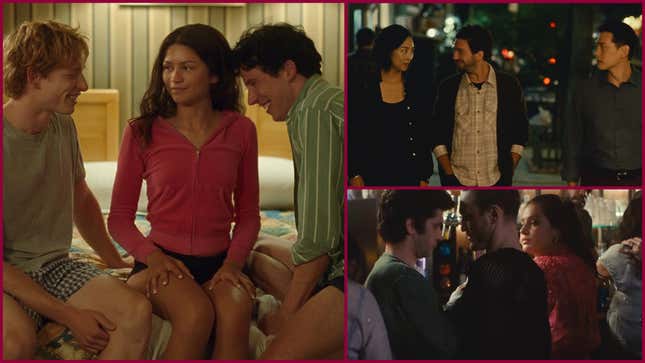
Summers of yore—hot girl summer, Barbenheimer summer, even white boy summer—have all been about de-centering detractors and stepping into one’s own individual power. That’s out for 2024. This summer, we’re not sidelining men; we’re finding two. Or two people of any gender—as long as there’s the right number of people to walk into a movie theater and ask for three tickets to Challengers, please.
If you’re not lucky enough to be in a decades-long, emotionally devastating but extremely sexually charged almost-throuple, you can always try being in a decades-long, emotionally devastating but distinctly non-sexual situation like in Past Lives. Or you can go out alone and wait for a couple to see you across the bar and really dig your vibe like Natalia Dyer did in the recent indie Chestnut. You can even enter into a messy trio that looks like a standard love triangle from a distance, but really contains an unprecedented measure of tenderness from all side, like the characters in festival favorites The Breaking Ice and, to a lesser but still present extent, Passages. Whatever your predilection, one thing is abundantly clear: three is the magic number in film right now.
We’ve been through love triangle phases before. The early-aughts were defined by the great Team Edward vs. Team Jacob wars, which eventually ceded their factions to the Peeta vs. Gale skirmish a few years later. There was even that weird Harry and Hermione arc the sixth and seventh Harry Potter movies forced on us in the 2010s. But if you consider the dynamics of those YA trios, it becomes apparent that none of the triangles in question were actually triangles at all. They were more like “love V’s” or “love vertices,” with two disparate points projecting desire at a shared object, and nothing but malice in the space between the opponents themselves.
That’s not the case anymore. Over the past two years, an increasing number of filmmakers have finally allowed the triangle to close. Part of the evolution, of course, is that society is far more comfortable putting bisexuality on screen than it used to be. It’s not that we’ve never had a fluid trio at the heart of a film before—Alfonso Cuarón’s Y Tu Mamá También obviously comes to mind. But a single (groundbreaking) film in 2001 to a decent handful in 2023/2024 alone is a notable evolution.
Challengers, Chestnut, and Passages all feature explicitly bisexual desire, where previously the connections between these characters might have been relegated to mere “homoerotic subtext.” All three also announce their queerness as casually as one might discuss the weather or an informal lunch plan, with no hemming and hawing about matters of identity, prejudice, or acceptance. They’re not “bi movies,” in the most base use of that phrase; they’re love triangle movies where one or more of the characters happens to be bi. All three of stories are infinitely sexier, more challenging, and more nuanced for that decision.
But even when there’s no pulsing Trent Reznor and Atticus Ross score to kiss your best friend to, the love triangle movies from these past few years still feel a little different. Filmmakers are continuing to acknowledge other forms of intimacy, as well as relationship models that don’t necessarily operate under strict cishet norms. In Passages, the two outer corners of the triangle end up sharing something far more honest and vulnerable with each other than the sex either of them (separately) has with the man they both covet. Past Lives is a study in restraint and radical empathy from all parties, where the same dynamic in a lesser film could have easily come to blows. The Breaking Ice sees a similar absence of jealousy from either of its respective men, instead focusing on the life-affirming friendship they share with one another. Even Challengers refuses to either prioritize or condemn any one side of its triangle, correctly treating the more public-facing romances between Tashi/Art and Tashi/Patrick as no more important than the concealed, complicated bond between its central childhood friends.
Unlike so many past films, the majority of these newer stories end in places of hope and connection rather than tension and eventual fracture. Despite everything they went through together, Julio and Tenoch are no longer speaking by the end of Y Tu Mamá También. In a largely monogamous world, it seemed for a while like that was the only way a polyamorous film could end; it was as if their characters needed to be punished somehow for stepping out of the status quo.
(Spoiler alert after the break—you’ve been warned!)
Two decades later, Art and Patrick are embracing on the court as their shared paramour screams in triumph from the sidelines. Past Lives’ Nora is still married to her lovely husband, who never once admonished her for carrying on an online relationship with the man she left behind, and even says he is glad to have met him when he comes to visit. Dyer’s Chestnut protagonist is gifted a rare moment of closure with both halves of her situationship. While a lot messier, even the two sympathetic survivors of the Passages trio end the film with an air of self-possession and confidence neither of them previously had.
We’ll see in the coming months and years if this trend continues, or if Hollywood drops the cheating pretense and instead commits entirely to full-on throuples and other poly dynamics. They’ve done it before; 1933's Design For Living, for example, featured one such trio a year before the institution of the Hays Code in 1934. But while that would be a welcome (r)evolution, it’s still incredibly fun to watch current filmmakers finally close the love triangle after all these years. It is the strongest shape, after all.